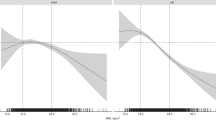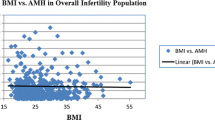Abstract
Purpose
Anti-Müllerian hormone (AMH) is a useful marker of ovarian reserve. Obesity/overweight are increasing and may affect the reproductive health. Previous studies regarding the effect of body mass index (BMI) on AMH levels are discordant. Our main goal was to evaluate the influence of BMI on AMH levels in women without polycystic ovarian syndrome.
Methods
Revision of medical records of 951 women who performed AMH determinations as part of their fertility workup, between 2011 and 2016.
Results
Median AMH concentration was 1.75 [interquartile range (IQR) 2] ng/mL (12.9 pmol/mL) and median age at AMH determination was 35 (IQR 6) years. These women evidenced a median BMI of 23 (IQR 5) kg/m2. Caucasian women were more represented [889(89.3%)]. Smoking habits (present/past) were present in 359(36.1%), and 147(14.8%) harboured a history of ovarian surgery. On univariable analysis AMH was not correlated with BMI (r = 0.048/p = 0.135); the only factors influencing AMH were age (p < 0.001), ethnicity (p = 0.004), and previous ovarian surgery (p < 0.001). On multivariable analysis, age was the only variable significantly associated with AMH, evidencing a reduction of 6.2% for each additional year (p < 0.0001). Furthermore, we verified a trend suggesting an AMH reduction of 22% (p = 0.08) in black patients comparing with the caucasian ones, when controlling for the other variables.
Conclusion
We report one of the largest series evaluating the influence of BMI on AMH levels and, consequently, on ovarian reserve. BMI does not seem to affect AMH levels. The reported concerns on infertility in overweight and obese women may be related to follicular development/oocyte maturation or endometrial disorders, rather than decreased ovarian reserve.

Similar content being viewed by others
References
J.A. Visser, I. Schipper, J.S. Laven, A.P. Themmen, Anti-Müllerian hormone: an ovarian reserve marker in primary ovarian insufficiency. Nat. Rev. Endocrinol. 8, 331–341 (2012)
A. Dumont, G. Robin, S. Catteau-Jonard et al., Role of anti-Müllerian hormone in pathophysiology, diagnosis and treatment of polycystic ovary syndrome: a review Dumont et al. Reprod. Biol. Endocrinol. 13, 137 (2015)
E.W. Freeman, C.R. Gracia, M.D. Sammel et al., Association of anti-Müllerian hormone levels with obesity in late reproductive-age women. Fertil. Steril. 87, 101–106 (2007)
World Health Organization, Fact sheet: obesity and overweight (2016), http://www.who.int/mediacentre/factsheets/fs311/en/. Accessed June 2017
E.W. Gregg, K.E. Shaw, Global health effects of overweight and obesity. N. Engl. J. Med. 12, 80–81 (2017)
M.W. Christensen, H.J. Ingerslev, B. Degn et al., Effect of female body mass index on oocyte quantity in fertility treatments (IVF): treatment cycle number is a possible effect modifier. a register-based cohort study. PLoS ONE 11, e0163393 (2016)
M. Nouri, E. Aghadavod, S. Khani et al., Association between BMI and gene expression of anti-Müllerian hormone and androgen receptor in human granulosa cells in women with and without polycystic ovary syndrome. Clin. Endocrinol. 85, 590–595 (2016)
S. Sahmay, T. Usta, C.T. Erel et al., Is there any correlation between AMH and obesity in premenopausal women? Arch. Gynecol. Obst. 286, 661–665 (2012)
L.G. Nardo, D. Christodoulou, D. Gould et al., Anti-Müllerian hormone levels and antral follicle count in women enrolled in in vitro fertilization cycles: relationship to lifestyle factors, chronological age and reproductive history. Gynecol. Endocrinol. 23, 486–493 (2007)
A.Z. Steiner, F.Z. Stanczyk, S. Patel et al., Anti-Müllerian hormone and obesity: insights in oral contraceptive users. Contraception 81, 245–248 (2010)
S. Halawaty, E. El Kattan, H. Azab et al., Effect of obesity on parameters of ovarian reserve in premenopausal women. J. Obstet. Gynaecol. Can. 32, 687–690 (2010)
R.S. Legro, S.A. Arslanian, D.A. Ehrmann et al., Diagnosis and treatment of polycystic ovary syndrome: an Endocrine Society clinical practice guideline. J. Clin. Endocrinol. Metab. 98, 4565–4592 (2013)
A. Iwase, T. Nkamura, S. Osuka et al., Anti-Müllerian hormone as a marker of ovarian reserve: what have we learned, and what should we know? Reprod. Med. Biol. 15, 127 (2016)
M.M. Zain, R.J. Norman, Impact of obesity on female fertility and fertility treatment. Women’s Health 4, 183–194 (2008)
M.A. Kominiarek, E.S. Jungheime, K.M. Hoeger et al., American Society for Metabolic and Bariatric surgery position statement on the impact of obesity and obesity treatment on fertility and fertility therapy endorsed by the American College of Obstetricians and Gynecologists and the Obesity Society. Surg. Obes. Relat. Dis. 13, 750–757 (2017)
B. Luke, M.B. Brown, J.E. Stern et al., Female obesity adversely affects assisted reproductive technology (ART) pregnancy and live birth rates. Hum. Reprod. 26, 245–252 (2011)
R.J. H. Norman, L.R. Chura, R.L. Robker, Effects of obesity on assisted reproductive technology outcomes. Fertil. Steril. 89, 1611–1612 (2008)
P. X. Bhide, A. Gudi, A. Shah et al., Serum anti-Mullerian hormone levels across different ethnic groups: a cross-sectional study. BJOG 122, 1625–1629 (2015)
M. Stracquadanio, L. Ciotta, M.A. Palumbo, Relationship between serum anti-Mullerian hormone and intrafollicular AMH levels in PCOS women. Gynecol. Endocrinol. 23, 1–6 (2017)
N.F. Z. Goodman, R.H. Cobin, W. Futterweit et al., American Association of Clinical Endocrinologists, American College of Endocrinology, and Androgen Excess and PCOS Society Disease State clinical review: guide to the best practices in the evaluation and treatment of polycystic ovary syndrome—part 1. Endocr. Pract. 21, 1291–1300 (2017)
Acknowledgements
The authors would like to thank to Dr. Susana Esteves, from the Clinical Investigation Unit, Instituto Português de Oncologia de Lisboa, Francisco Gentil, for her precious support on the statistical analysis.
Author information
Authors and Affiliations
Corresponding author
Ethics declarations
Conflict of interest
The authors declare that they have no conflict of interest.
Rights and permissions
About this article
Cite this article
Simões-Pereira, J., Nunes, J., Aguiar, A. et al. Influence of body mass index in anti-Müllerian hormone levels in 951 non-polycystic ovarian syndrome women followed at a reproductive medicine unit. Endocrine 61, 144–148 (2018). https://doi.org/10.1007/s12020-018-1555-y
Received:
Accepted:
Published:
Issue Date:
DOI: https://doi.org/10.1007/s12020-018-1555-y




